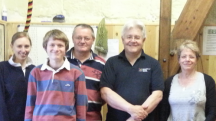Barry’s Barrow workshop brings ‘delight’
When people start to learn to ring, it’s a largely practical affair. There’s a little theory, such as an introduction to how a bell works, but their major goal is actually being able to control the instrument. Then, when they start attending normal practices, theory continues to be drip-fed and ringing terminology starts to embed itself. When the learner starts to take part in things beyond rounds there’s a need to teach more specific theory so that what they’re asked to try makes some sense. As people go further in their ringing and start to learn different methods they face the challenge of marrying up the details of a method on paper with the actual ringing of it in the tower; if they’ve started to gain an understanding of theory from an early stage this skill develops far more easily. The problem is that practice nights often don’t offer the time needed to get out the pens and paper, so a chat around a table is of great value.
On Sunday 9th Feb such a workshop was led by Barry Peachey. The plan was to use our dining room or the “Vicar’s Rooms” (church hall) depending on numbers. With numbers at about a dozen from 5 different towers, we decided that the dining room was just big enough and of course warmer! The group included those just about to move on from rounds, those learning the early stages of change ringing and also several ringing teachers who have very recently completed the ITTS Module 2 Day Course and are now beginning the practical skills development phase .
Barry started off the event with a background to change ringing and went on to include how Plain Hunt and Plain Bob are constructed, an exercise in how to write out a method from its Place Notation, the relationship between working bells, ie coursing order and a good deal of common terminology. The session finished with a summary handout of what had been covered and a discussion about the benefits of the Learning the Ropes ringers pathway.
Thanks to Helen Audley of Roos for her feedback on the afternoon:
“Many thanks for putting on the course today – and for your hospitality. I found it really useful to come along with our learners, because as well as picking up some tips for myself, it is good to observe which aspects they find easy, or difficult to grasp. The teaching of ringing is high on my agenda because it is a way of drawing families to the church who might not otherwise come. Even if they don’t stay for services, they see what goes on. ITTS Module 1 has made such a difference to the way I teach bell handling and it is such a joy to see a student put several steps together without batting an eyelid. For them it is no big deal because it is a natural progression (which is as it should be) whereas there I am skipping around the ringing room in delight – much to their bemusement. As for Module 2 – well, I put a few ideas into practice last Tuesday night and two people thanked me at the end saying how useful they found it. I am a teacher by trade and am very used to tailoring music and maths lessons to suit the individual. ITTS is giving me the resources to enable me to do the same when teaching ringing”.
Photo from ITTS Module 1 Day Course last year
Heather Peachey